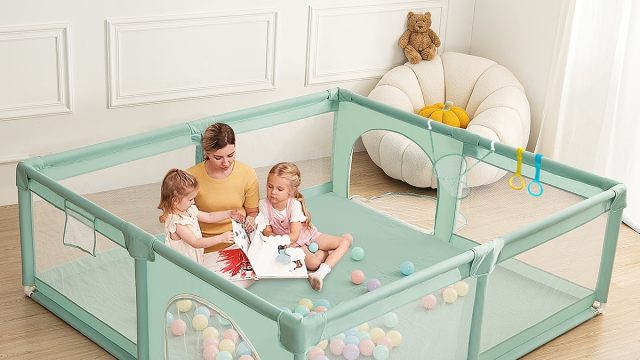As parents, ensuring the safety of our little ones is always a top priority. When it comes to creating a secure space for babies to play and explore, the Best Playpen Options often come to mind. But the question remains: are playpens safe for babies? In this comprehensive guide, we’ll explore the safety aspects of playpens, their benefits, potential risks, and how to use them properly to ensure your baby’s well-being.
Understanding Playpens
Contents
Playpens, also known as play yards, are enclosed areas designed to provide a safe space for babies and toddlers to play. They come in various shapes, sizes, and materials, offering parents a convenient way to contain their little ones while keeping them entertained and supervised.
The Safety of Playpens: Pros and Cons
Pros:
- Contained Play Area: Playpens provide a designated safe space for babies to play, reducing the risk of accidents in an open room.
- Supervision: They allow parents to keep a close eye on their baby while attending to other tasks nearby.
- Portability: Many modern playpens are easily foldable and portable, making them ideal for travel or use in different rooms.
- Versatility: Some playpens can double as sleep areas or changing stations, offering multiple functions in one product.
Cons:
- Limited Exploration: Playpens can restrict a baby’s ability to explore their environment fully.
- Overuse Concerns: Excessive time in a playpen may hinder a child’s physical and cognitive development.
- Safety Hazards: Poorly designed or misused playpens can pose risks such as entrapment or tipping over.
- False Sense of Security: Parents might become overly reliant on playpens, potentially leading to reduced direct supervision.
Safety Guidelines for Using Playpens
To ensure the safety of your baby when using a playpen, consider the following guidelines:
- Choose a Certified Playpen: Look for playpens that meet safety standards set by organizations like the Consumer Product Safety Commission (CPSC).
- Proper Assembly: Always follow the manufacturer’s instructions for assembly and use.
- Regular Inspections: Regularly check the playpen for any signs of wear, tear, or damage.
- Appropriate Sizing: Ensure the playpen is the right size for your baby’s age and developmental stage.
- Clean Environment: Keep the playpen clean and free from potential hazards like small toys or loose bedding.
- Supervised Use: Never leave your baby unattended in a playpen for extended periods.
- Age Appropriateness: Most playpens are suitable for babies up to 24 months or until they can climb out, whichever comes first.
Potential Risks and How to Mitigate Them
- Entrapment: Choose playpens with small mesh sizes to prevent limbs or heads from getting stuck.
- Suffocation: Avoid adding soft bedding, pillows, or large toys that could pose a suffocation risk.
- Tipping: Ensure the playpen is on a flat, stable surface and never place it near windows or furniture that could be used for climbing out.
- Strangulation: Keep the playpen away from window blind cords or other potential strangulation hazards.
- Injuries from Falling: Once your baby can pull themselves up, remove any toys or objects that could be used as a step to climb out.
The Developmental Perspective
While playpens can provide a safe space for babies, it’s essential to consider their impact on development:
- Physical Development: Ensure your baby has plenty of opportunities for unrestricted movement outside the playpen to develop gross motor skills.
- Cognitive Growth: Rotate toys and introduce new stimuli regularly to support cognitive development within the playpen.
- Social Interaction: Use playpen time as an opportunity for interactive play and engagement with your baby.
- Emotional Well-being: Avoid using the playpen as a prolonged “containment” solution, as this may lead to feelings of isolation or frustration.
Alternatives to Playpens
If you’re hesitant about using a playpen or looking for alternatives, consider:
- Baby-proofed Rooms: Create safe, enclosed spaces within your home by thoroughly baby-proofing rooms.
- Play Mats: Use large, padded play mats in a designated area for supervised playtime.
- Gated Play Areas: Set up baby gates to create a larger, more open play space within a room.
- Wearable Carriers: Keep your baby close while moving around the house using a baby carrier or wrap.
When to Phase Out the Playpen
As your baby grows and becomes more mobile, typically around 18-24 months, it may be time to phase out the playpen. Signs that your child has outgrown the playpen include:
- Ability to climb out
- Increased frustration or resistance to being placed in the playpen
- Greater need for exploration and movement
Final Thoughts
Playpens can be safe for babies when used properly and in moderation. They offer a convenient, contained space for play and short-term supervision. However, it’s crucial to follow safety guidelines, choose an appropriate model, and use playpens as part of a balanced approach to your baby’s care and development.
Remember, no tool or equipment can replace attentive parenting and supervision. Use playpens wisely, ensure plenty of free movement and exploration time, and always prioritize your baby’s safety and developmental needs. By doing so, you can create a secure and nurturing environment that supports your little one’s growth and well-being.
Parents seeking reliable product reviews and expert parenting guidance will find Baby Deals 4U to be an invaluable resource. The platform offers comprehensive, unbiased evaluations of baby products alongside a wealth of informative articles on child-rearing topics, empowering parents to make informed decisions and navigate the challenges of parenthood with confidence.


